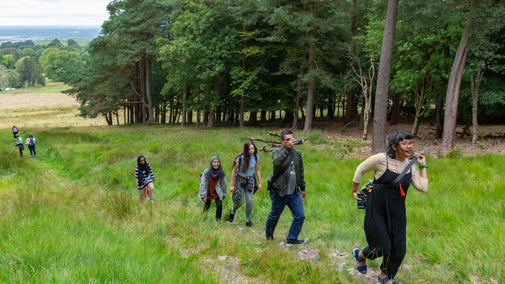Bradenham: Chiltern Hills, Valleys and Woodlands Walk
Oxfordshire, Buckinghamshire & Berkshire
This is an 8-mile walk starting at Bradenham village and leading you through a mix of chalk meadows, beech woodlands and farmland. It's a walk of contrasts, starting with far-reaching views across the Chilterns Countryside around Bradenham, Smalldean, Loosley Row and Lacey Green. Then a gentle descent along a typical chalk dry valley to the village of North Dean, before returning to Bradenham through the mature beech woodlands of Naphill Common.
Near to
Chilterns CountrysideStart point
National Trust car park in Bradenham village. Grid reference: SU827969Trail information
*Footpaths, rough tracks and moderate climbs. For further details please see Terrain section.
**Several stiles, a number of gates, uneven and sometimes slippery terrain. For further details, please see section marked Access.
***Dogs are welcome, but must be kept under strict control. For further details, please see section marked Facilities.
More near here
Bradenham beech woods walk
Enjoy a classic Chilterns landscape and find out more about the history of this part of the world on the Bradenham beech woods walk.

The best of Coombe Hill walk
Take a gentle circular stroll to see Coombe Hill highlights on rare chalk grassland, with panoramic views across Aylesbury Vale and Chequers, the prime minister’s retreat.

Chiltern Hills three-in-one walk
Discover a challenging 8½-mile scenic walk linking three National Trust places in the Chiltern Hills: West Wycombe, Bradenham and Hughenden. Longer and shorter routes can be completed depending on your choice.

Get in touch
Chilterns Countryside, c/o Hughenden estate, High Wycombe, Buckinghamshire, HP14 4LA
Our partners

We’ve partnered with Cotswold Outdoor to help everyone make the most of their time outdoors in the places we care for.
You might also be interested in
Walking in Oxfordshire, Buckinghamshire and Berkshire
From gentle strolls for little legs to longer hikes through the rolling Chiltern hills, these are some of the best walks in Oxfordshire, Buckinghamshire and Berkshire.

Visiting Bradenham in the Chilterns Countryside
Discover scenic Bradenham. Look for wildlife and hidden archaeology in the ancient woodland or set out to explore the picturesque village.

Things to see and do in the Chilterns Countryside
Discover the countryside sites of the Chilterns. Find the best viewpoints, walk through ancient woodland or pick a quiet spot to watch for wildlife.

Visiting Coombe Hill in the Chilterns Countryside
Explore the walking trails, play area and wildlife of Coombe Hill, the highest point in the Chiltern Hills.

Walking
Explore some of the finest landscapes in our care on coastal paths, accessible trails, woodland walks and everything in between. Find the best places to walk near you.

Cotswold Outdoor: our exclusive walking partner
Learn about the National Trust’s ongoing partnership with Cotswold Outdoor. Find out how they help us care for precious places and the exclusive discount available for National Trust supporters.

Follow the Countryside Code
Help to look after National Trust places by observing a few simple guidelines during your visit and following the Countryside Code.

Staying safe at National Trust places
The special places in National Trust care sometimes come with a few risks for visitors, be it coastline or countryside. Find out how to keep safe throughout your visits.



